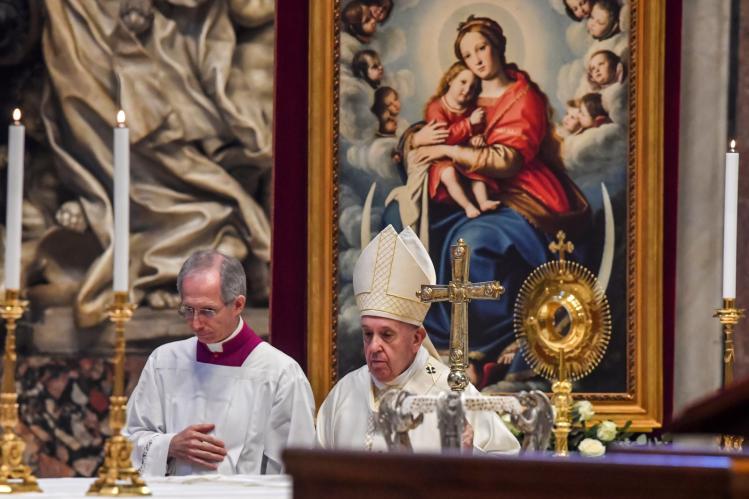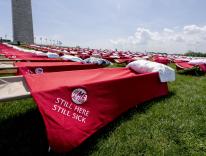
If there’s something positive to have emerged from these many months of pandemic, it’s the constructive thinking going on about what it might mean for the Catholic Church. There’s a kind of collective and individual self-examination underway, perhaps exemplified best by Czech theologian Tomáš Halík, who is a psychotherapist by training. As he put it in one of the most perceptive articles published recently on the topic: “Our time of civilizational change calls for a new theology of contemporary history and a new understanding of the church.”
Worldwide, the pandemic has revealed examples and witnesses of holiness, of living the Gospel, often in straightforward but “anonymously Christian” ways. The virus has masked us and at the same time it has unmasked hypocrisies that are deeply ingrained in contemporary forms of militant Catholicism, such as the absolutist pro-life and religious liberty stances and rhetoric that ignore the fact that protecting the health and life of others outweighs your own proclaimed indifference to the risks to your health and life.
The crisis has also dispelled the illusion that the Church can be a space exempt from what happens outside of it. We can see this in the profound disorientation the institutional Church seemed to experience in contending with measures made necessary by widespread infection. Forced to operate within the restricted spaces defined by health-protection guidelines, it seemed unable to respond with anything more than what read like pre-written answers to pre-written questions. This has been most apparent in the “Eucharistic obsession,” which has sometimes taken on the characteristics of a fetishistic abstinence more than of a spiritual need. Even worse, some of the disputes between the Catholic Church and political authorities felt like twenty-first-century versions of eleventh- and twelfth-century clashes with empire in defense of a medieval idea of “liberty of the Church,” not as debates inspired by the contemporary Catholic understanding of religious liberty.
But in these last few months we’ve also witnessed, once again, the arrogance of power, the recurrence of internecine conflicts, and the persistence of particular ecclesial interests. The difficulty of these times has likely ended any dream of palingenesis, any expectation that we can imagine a new institutional Church. Ecclesial reform? The fact is that the pandemic has exacerbated the typically Catholic ecclesial distancing between clergy and laity, and helped the institutional Church reinforce its centrality. All its energies have been spent in keeping the existing system going, especially in terms of liturgy and Church governance. Even granting some exceptions, the clergy remain in charge of liturgy, and from the pope on down they have shown limited creativity in inserting something into the symbolic discourse. For example, it would have been a sign if, at least on one weekday, the pope had celebrated in Santa Marta not Mass, but a liturgy of the Word. The Eucharistic fast would then have united the whole body of Christ. But it’s not just clerical control of the liturgy. The Catholic laity have been dispersed and almost voiceless, except in their invisible domestic liturgies and private spiritual expressions. As for the professional theological commentariat, it had to reckon once again with the problem of appearing superfluous and needing to justify its existence against the urgent needs of the community of the believers.
The fact is that crises like the pandemic may reveal institutional weaknesses, but they can also amplify institutional advantages at both the local and the universal levels. That is the situation we’re seeing now with the institutional Church. My impression is that the balance has changed. A barely visible laity has become practically invisible, while the vulnerabilities of the professional community of theologians—who are dependent on an increasingly unstable system of private Catholic colleges—have been shown. Meanwhile, a clerical system with strong political links is now even more capable of asserting its power: the voice of the Catholic Church in the mass media is largely and by default still the voice of the clergy.
Even if “the life” of the Church as an institution has been suspended by the pandemic, the institution itself remains a pervasive presence. Ask those who’d planned weddings or First Communions, or who found themselves having to organize a funeral for a family member. I suspect that some of the dreams of ecclesial and liturgical rebirth were an echo of a late-Enlightenment aspiration to intellectual and spiritual adulthood, in the sense of establishing independence from external structures. But those who during the pandemic had to care for the spiritual needs of the elderly and the sick, or for small children missing the children’s liturgy of the Word with their schoolmates, are probably a little less confident about their ability to do just fine without the institutional Church. It was probably wishful thinking to view this crisis as an opportunity to reimagine the liturgy in a progressive way, or to do away with clericalism in favor of community-centered reform. Maybe the moment has revealed cracks in political conservatism, but the same cannot be said about the clerical component of the Catholic Church, at least in this part of the world.
Of course, the pandemic also casts a light on what the pontificate of Francis means, beyond the small quarrels about this or that particular aspect of his teaching and policies: the transition to a spiritual and theological hermeneutic of incarnate reality as it is and as there is. Given the necessity and urgency of this transition, the institutional problem of the Catholic Church only gets more serious. We still rightfully expect the bishops to react against what we find a scandal to the Gospel. This is why so many have found the recent accommodating words from Catholic prelates to Donald Trump particularly revolting. Even if Catholics have largely stopped waiting for direction from the bishops on certain issues, we still want to be represented by the institutional Church before the highest political office in the land, especially in an election year.
There is no question that the Church must begin again from the kerygma and go forth in the heart of our world. But there is an emptiness at the institutional level (and the ecclesial, and the political) that cannot be filled by the anti-institutional or post-institutional. The pandemic, forcing four months (and counting) of social and ecclesial dispersion, is likely to generate an updated theory of the relationship between “believing and belonging.” It’s shown that for all the fragility of the institutional system, its persistence is undiminished. This is in some ways a constitutional moment, for both our Church and the world. Our experience with the ecclesial system over the last few months has shown us the difference between dreams and reality.
Please email comments to [email protected] and join the conversation on our Facebook page.
Previous Story
The Power of Conservative Nostalgia
Next Story
Anything but Ordinary

